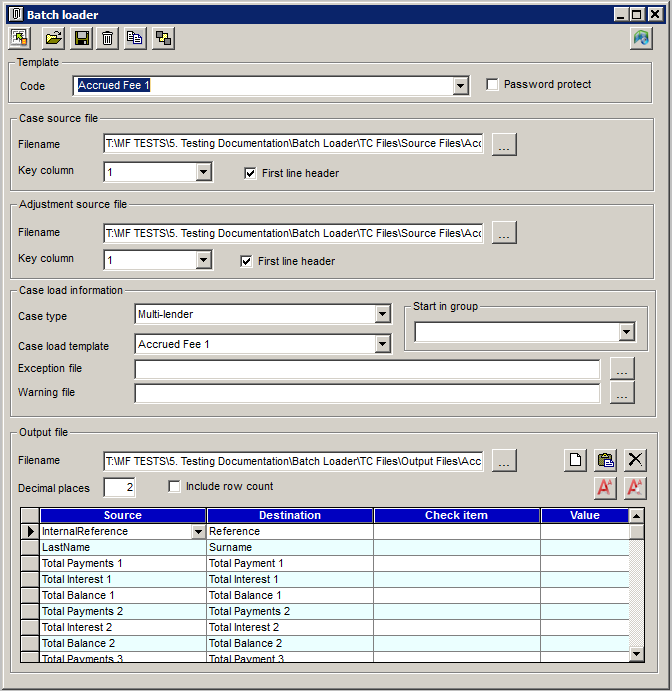The batch loader is a optional feature which works with the case loader, adjustment loader, wizards and mail merge option to create a powerful batch processor when many cases are needed to be processed.
This option can load data in from your source files and be configured to process any kind of Redress Manager case.
Passwords have been introduced within the various case and adjustment load templates and are encrypted to ensure these can only be changed by authorised individuals as they are a key part of the loading process. Password can have a length of 30 characters.
Batch loader will accept both CSV and Tab files (this is based on the Case loader being either CSV or tab separated) and they also allow these files to have delimiters within quotation marks. If the Case loader template is set to comma separated and a Tab file is chosen as the source in the batch loader template or vice versa, on running the batch the system will display an error message.
The batch loader screen allows various templates to be created.

|
a) |
Select an existing template or create a
new one |
|
|
b) |
Select to add password. Password can have a length of 30
characters. |
|
|
c) |
Case source file e.g. customer information (Can use parameters for user variables
{UserVariable}, day {d}, month {m}, year {y} and batch number {b}.) |
|
|
d) |
Key
column for matching to transaction data |
|
|
e) |
First
line header |
|
|
f) |
Adjustment
source file e.g. transaction data (Can use parameters for user variables
{UserVariable}, day {d}, month {m}, year {y} and batch number {b}.) |
|
|
g) |
Key
column for matching to customer case information |
|
|
h) |
First
line header |
|
|
i) |
Case
load type for template selection and result processing |
|
|
j) |
Case
load template |
|
|
k) |
Select
group to for batch to run within |
|
|
l) |
Filename
for logging exceptions during a wizard process (Can use parameters for user
variables {UserVariable}, day {d}, month {m}, year {y} and batch number {b}.) |
|
|
m) |
Filename
for logging warnings during a wizard process (Can use parameters for user
variables {UserVariable}, day {d}, month {m}, year {y} and batch number {b}.) |
|
|
n) |
Output filename for results (Can use
parameters for user variables {UserVariable}, day {d}, month {m}, year {y}
and batch number {b}.) Output
files with a .txt, .tab or .tsv extension produces tab file outputs and those
with a .xml extension produces XML file outputs. Any other output files types
configured produces csv file outputs. |
|
|
o) |
Decimal places for numeric data |
|
|
p) |
Include row count in file which shows the
number of rows added to the file. |
|
|
q) |
Output file source field (based on case
type), entries can be formatted to give required output values (e.g.
{format(createdDate,’dd/mm/yyyy’)} |
|
|
r) |
Destination field (name of field in result
set) |
|
|
s) |
Check item for validating data |
|
|
t) |
Value to match e.g. <> 0. Can also
include VBscript functions. |
|
|
|
|
|
|
|
Load in data from external
file |
|
|
|
Load Case load template |
|
|
|
Save Case load template |
|
|
|
Delete template Import/Export template |
|
|
|
Exit Case load screen |
|
|
|
Browse to find file |
|
|
|
Increase font |
|
|
|
Decrease font |
|
|
|
Version Information (including
created, modified and imported dates) |
|
When processing, the batch processor works by loading all the case and transactional information into some holding batch tables. This data is then processed by the case loader, which calls a wizard to load in the adjustment information and process the case. The wizard can perform mail merge or create the data to be used in processing the output results. Several sessions can be run through an SQL command on a PC for a faster and more efficient process.
Whilst processing file names are stored as system variables: BatchOutput, BatchExceptionFile, BatchWarningFile, BatchCaseFile, BatchTranFile. The output file locations can be altered during the execution of the batch,
When merging many hundreds of letters, creating a file may be advantageous rather than processing individual letters.
A user can stop a running batch, by selecting ‘Stop batch ‘option under the Admin menu. When this option is used, an entry is made to the system audit. Please note that this option can only be seen when the batch is running.
Related Topics


